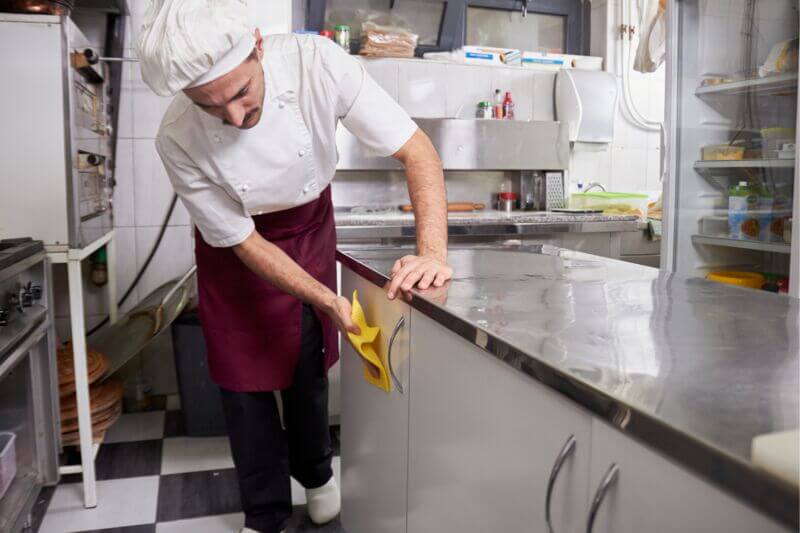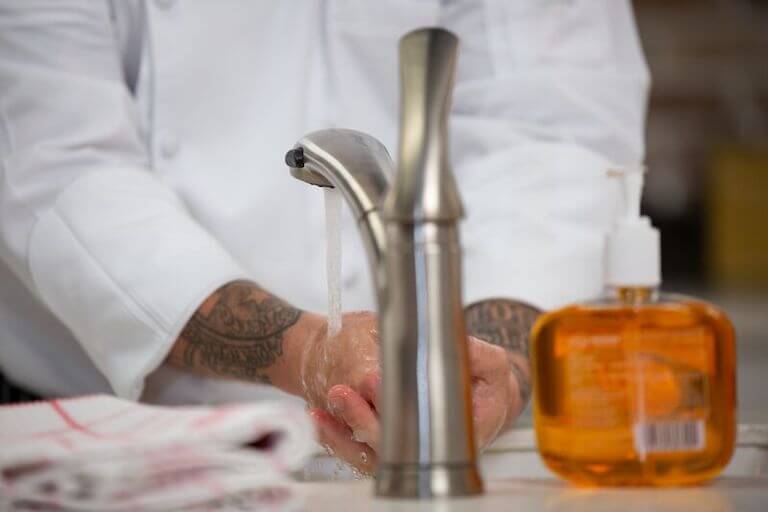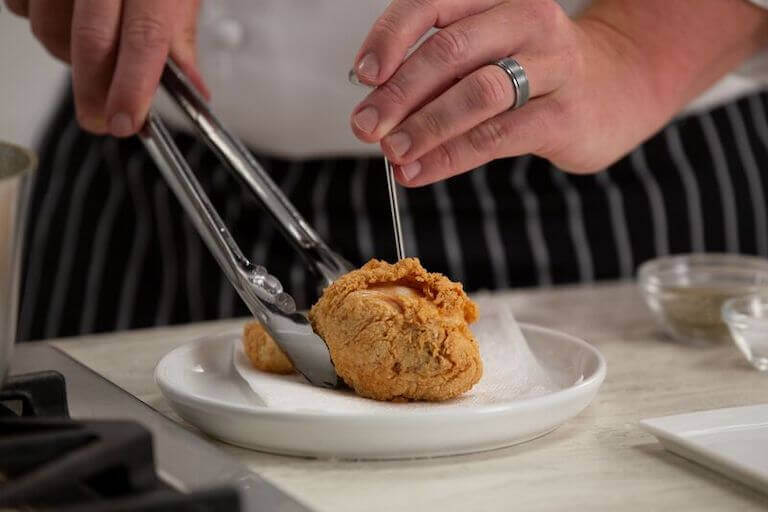The dinner rush can be pure chaos. Flames shoot up from sauté pans, tickets keep flying in, and you’re moving fast. One wrong move, like forgetting to wash your hands after handling raw chicken, and suddenly you’ve got dozens of sick customers on your hands.
Because the stakes are so high, Auguste Escoffier School of Culinary Arts can help students establish professional food safety habits from the start. Washing hands properly, checking temperatures, keeping raw meat away from everything else—before students ever work a real dinner service, they’ve drilled the basics so many times that they should happen naturally.
Being meticulous in the kitchen is essential. So how do future chefs build those habits at Escoffier, and why does it matter beyond the classroom? Let’s take a closer look.
Why Food Safety Is a Cornerstone of Professional Culinary Training
Food safety is a critical issue that affects public health worldwide. According to the World Health Organization (WHO), an estimated 600 million people, almost 1 in 10 globally, fall ill after consuming contaminated food, and 420,000 deaths occur each year as a result. Children under 5 are particularly vulnerable, carrying 40% of the foodborne disease burden.
This widespread problem underscores the importance of proper food handling practices in every kitchen. In fact, nearly half of all food-borne illness outbreaks occur in restaurants, and many of these outbreaks come from preventable handling mistakes. Here are the five leading root causes of why restaurant outbreaks occur:
- People: Lack of adequate training and manager oversight
- Equipment: Refrigerators and freezers that aren’t reliable or large enough for all perishable foods
- Economics: Employees may come in sick if they don’t have sick leave
- Process: Food that isn’t processed correctly
- Food: Food that isn’t stored correctly or kept away from pests
The scale of the problem and the seriousness of the health risks highlight why food safety needs to be part of every chef’s daily routine. In programs like those offered at Escoffier, food safety is taught as a practical skill and reinforced throughout the coursework, so students are prepared to carry those skills into their food service careers.
Three Preventable Causes of Foodborne Outbreaks
- Contamination: Pathogens or hazards get into the food
- Ex: A chef doesn’t thoroughly wash their hands after using the restroom and then handles food
- Proliferation: Pathogens already in the food reproduce rapidly
- Ex: Food is stored at the wrong temperature
- Survival: Pathogens survive a process that was intended to kill them
- Food is not cooked to a high enough internal temperature
Source: “Contributing Factors,” Centers for Disease Control and Prevention

Keeping workspaces clean can reduce contamination risks in professional kitchens.
How Escoffier Introduces Food Safety
Students begin their programs with courses that cover topics such as the essentials of food safety and sanitation in a professional kitchen. The coursework can cover proper hygiene, safe food handling and storage, cleaning procedures, pest control, and the role of kitchen layout in maintaining safe operations.
Core Food Safety Concepts
Here’s a look at how some of these lifelong skills are developed.
Personal Hygiene Is the First Step
Proper hygiene might not be glamorous, but it can be one of the most effective and inexpensive ways to prevent diseases like Hepatitis A from spreading through your kitchen. Students discover why thorough handwashing matters, how to keep uniforms actually clean (not just looking clean), and why a spotless workstation isn’t optional.

Handwashing is your first line of defense against food contamination.
Handling Food Safely to Reduce Risk
Safe food handling comes down to a few key practices that can prevent most problems before they start. Keep raw and cooked foods separate (use different cutting boards for raw meat and produce), sanitize food contact surfaces between prepping different foods, store everything at the proper temperatures and check them regularly, and don’t store raw items above ready-to-eat items.
Why Do Different Proteins Require Cooking To Different Internal Temperatures?
Here’s something that can trip up a lot of new cooks: not all proteins need the same minimum internal cooking temperature to be safe. Chicken has to reach 165°F to kill salmonella, but a beef steak is usually fine at 145°F because the bacteria like E. coli and listeria live primarily on the surface of whole cuts, where they can be killed at lower cooking temperatures. Ground beef is a different story. Because bacteria can get mixed throughout when it’s ground, cook it to 160°F to be safe.
Key takeaway: Internal temperature targets depend on both the type of protein, how it is prepared for cooking, and the kinds of bacteria it is most likely to harbor.

Monitoring internal temperatures can help prevent foodborne illness.
Keep Pests Out
Nobody wants to find unwelcome visitors in their kitchen. Students explore how to spot potential pest problems early and set up protocols to deter them, like storing ingredients in sealed containers, managing waste properly, and sealing off entry points where vermin might sneak in.
Understand Allergen Safety
Food allergies are to be taken seriously. If a customer says they’re allergic to shellfish, the restaurant should do more than simply avoid putting shrimp on their plate. The workspace should be properly sanitized and could be separate from other spaces. Different cooking utensils and equipment should be used (like, for example, a separate pot of oil for fried shellfish) to avoid cross-contact. Even trace amounts of an allergen can cause a dangerous reaction, so careful handling is part of protecting every guest who walks through the door.
Want to Learn More About Allergen Safety? Read This Next: A Guide to Reading Food Labels: What Every Culinary Student Should Know
4 Quick Kitchen Safety Tips Chefs Swear By
Safe food handling doesn’t have to be complicated, but it can be easy to slip up when things get hectic. Practice these until they become automatic:
- Wash hands thoroughly and often
Handwashing before handling any food and after touching raw ingredients is the first line of defense against contamination. - Keep knives sharp and store them safely
Sharp knives are safer than dull ones. With a dull knife, you’re pushing harder to make cuts, which means you’re more likely to slip and cut yourself. - Monitor food temperatures carefully
Cook your proteins hot enough to kill bacteria like Listeria, E. coli, and Campylobacter. Keep a cheat sheet with safe cooking, holding, and storage temperatures prominently displayed in the kitchen. - Stay organized throughout your shift
Maintaining a clean workstation reduces the risk of cross-contamination and can make kitchen operations smoother.
Food Safety Certifications: Why They Matter in Culinary Education
Restaurant workers and managers with formal food safety training are more likely to pass food safety knowledge tests than those without, according to CDC research. For culinary students, understanding these standards can be a key step in preparing for a professional kitchen.
Types of Food Safety Standards and How They Relate to Culinary Training
Most states require that at least one employee at a food service establishment have a food safety manager certification. In some states, you also need food-allergen safety certification.
ServSafe and StateFoodSafety vs HACCP
ServSafe and StateFoodSafety: Both certify food handlers and managers in safe food practices—covering sanitation, storage, hygiene, and allergen control. These programs help workers meet regulatory requirements and reduce the risk of foodborne illness. If you work in a restaurant, chances are you’ll need either a Food Protection Manager certification or Food Handler certification. It covers the basics: proper food handling, sanitation, storage practices, and allergen management.
HACCP (Hazard Analysis and Critical Control Points): HACCP works differently from ServSafe. It involves identifying potential hazards, setting up checkpoints to monitor critical factors like temperatures, and creating plans for when something goes wrong.
Using HACCP Principles to Improve Kitchen Safety
HACCP gives you a game plan for preventing food poisoning:
- Identify potential hazards: Assess risks at every stage, from sourcing ingredients to serving finished dishes
- Monitor critical control points: Track the conditions most likely to affect safety, such as storage temperatures and cooking levels.
- Maintain ongoing oversight: Regularly verify temperatures, sanitation practices, and cleaning procedures.
- Fix problems fast: Have a plan ready for when something breaks or goes wrong, like when a freezer stops working.
- Write it all down: Keep thorough records to demonstrate compliance with food safety standards.
Certification Could Improve Your Job Prospects
Certified chefs and managers can be better prepared to prevent foodborne illness and could be more competitive in the job market. Plus, if you’re already certified when you apply, you may help employers meet state requirements without extra on-the-job training.
Starting Your Culinary Education with Food Safety in Mind
From dressing in your chef’s whites and washing hands at the start of service, to meticulously cleaning after service, a chef’s day starts and ends with safety.
At Escoffier, food safety practices are reinforced throughout the curriculum and integrated directly into lab work, so they become part of the cooking process rather than an afterthought. Through consistent repetition, safe habits are strengthened until they become second nature in the kitchen.
Ready to find out more about building a strong culinary foundation? Contact us to explore the ways Escoffier can support your journey.
Want to find out more? Check Out These Articles Next:

